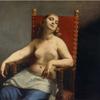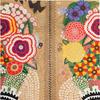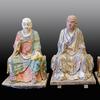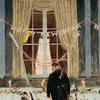Dallas Museum of Art Organizes Its First Exhibition Dedicated Exclusively to Andean Art
- DALLAS, Texas
- /
- May 14, 2015
The Dallas Museum of Art presents Inca: Conquests of the Andes/Los Incas y las Conquistas de los Andes, an exhibition of over 120 objects that explores the dynamic nature of state expansion and imperial conquest through Andean visual arts. On view May 15 through November 15, 2015, the exhibition is the first organized by the DMA dedicated exclusively to Andean art, and the first special exhibition organized and curated by Dr. Kimberly L. Jones, The Ellen and Harry S. Parker III Assistant Curator of the Arts of the Americas. As the title suggests, the exhibition is presented in both English and Spanish. Featuring important works from the DMA’s Arts of the Americas collection, some displayed for the first time, and several significant loans, Inca: Conquests of the Andes reflects the traditional media of Andean visual arts, from ceramic and wood vessels to highly prestigious gold, silver, feather, and textile accoutrements.
“Inca: Conquests of the Andes focuses on the impressive complex societies of western South America, those cultures that developed across the Andean highlands and desert coast for thousands of years prior to the Spanish Conquest. Curated by the DMA’s Kimberly Jones, an eminent scholar in the arts of the Americas with a decade of archaeological fieldwork experience in Peru, this exhibition offers visitors the remarkable opportunity to learn about a thousand years of artistic achievements, and to view rarely seen work from the DMA’s collection,” said Maxwell L. Anderson, The Eugene McDermott Director of the Dallas Museum of Art.
“This exhibition has provided the fabulous opportunity to share a deep admiration of Andean cultures with the greater public, for a mutual appreciation of this region so rich in cultural heritage. It has also presented a wonderful opportunity to provide further conservation, material study, and research to the impressive collection of Andean arts long stewarded by the Dallas Museum of Art.” added Dr. Jones.
The Inca Empire developed through the 15th and early 16th centuries, encompassing the central Andes of South America. The Inca called this empire Tahuantinsuyo—or “land of the four parts,” defining regions north, east, south, and west of the capital, or seat of the king—Cuzco. Before and after the Inca Empire, political expansions by local states, such as the Huari and Chimú, or foreign empires, like the Spanish, continually transformed the Andean coast and highlands. The visual arts of these historical periods reflect the dynamism of such cultural convergence.
Inca: Conquests of the Andes conveys the richness of over 1,000 years of Andean cultural history in thematic sections, and includes these highlighted works of art:
The Inca Conquest opens the exhibition with the DMA’s Inca key checkerboard tunic, arguably the finest example of this standardized Inca tunic type outside of Peru. Beginning with this vibrant male garment, the exhibition features five of the Museum’s most impressive tunics in central locations within the successive gallery spaces, permitting visitors to walk around the finely woven garments as they would appear worn on high-ranking males of the respective societies. Focused on conquest, the gallery also engages Andean weaponry and military status through metal knives (or tumi), mace heads, and braided slings.
Forging Connections presents key aspects of Andean practice and Inca ritualism that served to connect the diverse and increasingly widespread imperial territories. The gallery highlights the DMA’s rich assortment of decorated Andean woven and net bags often used for carrying coca leaves, as well as small intricate objects associated with coca and ritual practices. The role of miniatures in Andean practice is exemplified through the display of precious Inca miniature silver and gold figurines that reflect the ideal male and female Inca elites.
Foundations explores the pre-Inca polities, such as the Huari and Tiahuanaco, which provided substantial practical and ideological bases for later Inca imperial expansions. The room revolves around the impressive Huari male tunic from the DMA’s collection, while it explores the vibrant range of other Huari and Tiahuanaco provincial styles and objects, many on exhibition for the first time, including mantles and fine tapestry bags with ornate imagery. The gallery theme is enriched substantively by a generous loan from the Kimbell Art Museum of a precious Huari standing figurine.
Hybrid Arts presents the complex dynamism of coastal and highland cultural interactions from the perspective of north coast Sicán and Chimú visual arts. The gallery highlights not only the DMA’s Sican gold beakers but also an assortment of silver cups and intricate silver ornaments, which are laden with coastal motifs. The Inca-style urpu, a storage vessel for Andean maize beer, serves to address Inca influence among the coastal provinces.
Andean Textile Arts provides a diverse array of pre-Hispanic Andean textiles, including both standardized designs and hybrid productions of male and female garment types. Tunics from the Andean central coast convey the vibrant patterns of fine tapestries while examples from the north coast present the dramatic simplicity of painted fabrics. The gallery includes examples of ornamented pre-Hispanic Andean weaving implements and loom parts.
The Spanish Conquest opens with a generous loan from the Mel Fisher Museum in Key West of an intricately decorated silver bowl recovered from the famous Spanish galleon Nuestra Señora de Atocha, which sank in 1622 off the coast of modern Florida. Juxtaposed with its Spanish form, the bowl addresses Inca social practice with paired feasting cups and Andean traditional weaving. These themes are richly explored through the display of the DMA’s impressive Spanish colonial poncho, as well as the representative collection of wooden goblets (or quero) carved, painted, and modeled with vibrant images of Andean conception.
Of special note, during development of the exhibition, the ancient textiles, metal objects, and ceramics received conservation treatment and material study through the Museum’s conservation department and studio, and through collaboration with a specialized textile conservator. The conservation work and material studies at the DMA were performed by Fran Baas, the DMA’s Associate Conservator of Objects.
Inside the exhibition, visitors will find an education space dedicated to explaining the labor-intensive process of creating a textile, including the intricate weaving processes used by the artists represented in the exhibition. Visitors will be able to touch samples of the weaving techniques generously produced by faculty and students at the University of North Texas for this exhibition. Each of the techniques will have an associated icon that will appear on textile object labels throughout Inca: Conquests of the Andes, identifying relevant textile production techniques.
DMA Friends will be able to earn the Inca: Conquests of the Andes Special Exhibition Badge. On opening day, Dr. Jones will provide a public lecture about the exhibition during the Museum’s May Late Night on Friday, May 15, 2015, at 7:00 p.m. Additional programs will be scheduled throughout the run of the exhibition. For details, visit DMA.org. For more information on the DMA Friends program, visit DMA.org/friends.
Inca: Conquests of the Andes requires a special exhibition ticket of $16 for adults, with discounts for students, military personnel, and seniors; DMA Partners and children 11 and under are free. Active-duty military personnel and their immediate family members will receive free admission to the exhibition from May 26 through September 6, 2015, as part of the Blue Star Museums Program.












_-Closing-the-Distance_100x100_c.jpg)









